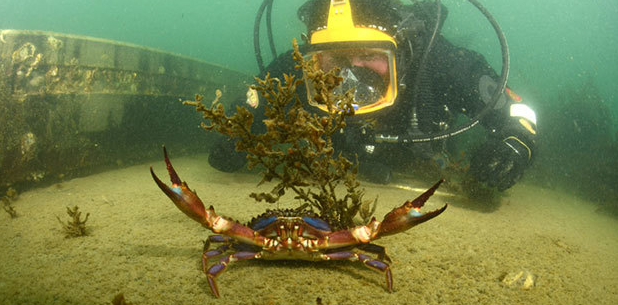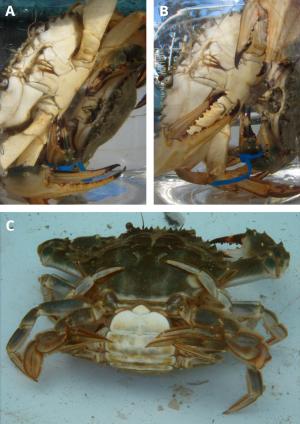Hard shell mating and response to sex pheromones in the Asian paddle crab

The Asian paddle crab, Charybdis (Charybdis) japonica, has been present in New Zealand since at least 2000 and has established sizeable populations in parts of northern New Zealand. The mating strategies of most species of Charybdis are not well known. In other paddle crabs (Portunidae), the male search and courting response is driven by sex pheromones released by female crabs during the pre-moult stage. However, our experiments showed that the Asian paddle crab can mate while the female is still in the hard shell phase. They don't need to wait for moulting to occur. Our results suggest that receptive females choose when to mate and release sex pheromones. Males do not guard the females after they have mated and the female can quickly re-pair with another male. This behaviour is not common in other hard shell mating portunid species.
As part of this work, we also evaluated the utility of uridine diphosphate (UDP) as a potential tool to enhance capture rates of the paddle crabs. UDP was identified as the female sex-pheromone in the European green crab, Carcinus maenas, and it has been shown to elicit a sexual response in several other crab species. Our native paddle crab, Ovalipes catharus, which is a commercial species, displayed a weak behavioural response towards UDPÂ but the Asian paddle crab did not exhibit an attraction or cradling response in the presence of the pheromone.
 Read more about the Asian paddle crab.
 [Image: Cindy Baker, NIWA] |
Figure 1: Copulation/mating in Charybdis japonica. A, the female is held upside-down beneath the male. B, the extended male abdomen and copulatory pleopods are visible inside the female abdomen. C, posterior view of the male abdomen extended inside the open female abdomen with the female grasping the male carapace with her pereiopods. |
Additional reading:
- Baker, C. F., Gublin, Y. and Reeve, K. A. (2018). Observations of hard-shell mating in the portunid crab Charybdis japonica (A. Milne-Edwards, 1861) (Decapoda: Brachyura). Journal of Crustacean Biology ruy029-ruy029.
Key contacts
| Cindy Baker |
| Principal Scientist |
| NIWA |
| [email protected] |